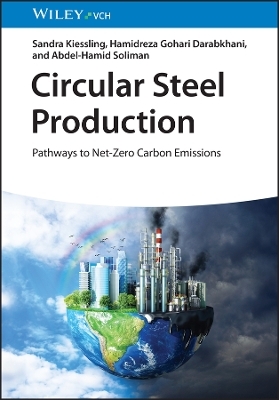
Circular Steel Production
Wiley-VCH (Verlag)
978-3-527-35315-6 (ISBN)
- Noch nicht erschienen (ca. März 2025)
- Versandkostenfrei innerhalb Deutschlands
- Auch auf Rechnung
- Verfügbarkeit in der Filiale vor Ort prüfen
- Artikel merken
1: HISTORY OF STEELMAKING
1.1 How it all began
1.2 First attempts at steelmaking
1.3 Steelmaking process development
2: STEELMAKING PROCESSES
2.1 Introduction
2.2 Raw Materials
3: INTRODUCTION TO THE BIO STEEL CYCLE
3.1 Introduction
3.2 Motivation
3.3 BF/BOF route carbon capture
3.4 BF/BOF off-heat utilisation
4: THE KEY COMPONENTS OF THE BIO STEEL CYCLE (BISC)
4.1 Introducing the BiSC key components for net-zero carbon steel manufacturing
4.2 BF/BOF route carbon capture
4.3 BF/BOF off-heat utilisation in iron and steelmaking
4.4 Renewable energy technologies
4.5 DAC Woodlands
4.6 CEPS
4.7 Geomimetic® Process
4.8 Anaerobic digestion
4.9 Sewage treatment
4.9 Biogas, biomass and hydrogen
5: MULTI-CRITERIA DECISION ANALYSIS (MCDA) FOR BISC (BIO STEEL CYCLE)
5.1 Introduction
5.2 Basics of MCDA for BiSC
5.3 MCDA for BiSC
5.4 MCDA sensitivity analysis to variation in scores or weighting
5.5 MCDA examination and analysis of the derived results
5.6 MCDA Conclusions and discussion
5.7 The Bio Steel Cycle implementation stages, support schemes and cost
5.8 Conclusions and discussion
6: THE CAT AND REDUCING EFFECTS OF THE BISC KEY COMPONENTS IMPLEMENTATION
6.1 Introduction
6.2 BF/BOF route carbon capture
6.3 Renewable energy technologies
6.4 DAC Woodlands
6.5 CEPS and Geomimetic® process
6.6 Anaerobic digestion, sewage treatment
6.7 Biomass, biogas and hydrogen
6.8 CCUS
6.9 Validating process flowcharts and simulations
6.10 Findings
7: GREATER ENERGY INDEPENDENCE WITH SUSTAINABLE STEEL PRODUCTION
7.1 Introduction
7.2 Materials and methods
7.3 Heat loss recovery - energy and CO2 saving protocols
7.4 Retrofitting renewable energy technologies on site
7.5 Conclusions
8: TECHNOLOGICAL CHALLENGES TO AND OPPORTUNITIES OF THE BISC CONCEPT IMPLEMENTATION
8.1 Introduction
8.2 Challenges
8.3 Opportunities
8.4 Conclusions
9: SKILLS SETS REQUIRED WITHIN THE DIFFERENT COMPONENTS AND SECTORS
9.1 Introduction
9.2 Solar
9.3 Wind turbines
9.4 Hydro
9.5 Geothermal
9.6 Green Hydrogen
9.7 Biomass
9.8 Biogas
9.9 Conclusion
10: THE FUTURE OF GREEN STEEL
10.1 Introduction
10.2 United Kingdom
10.3 United States of America
10.4 Brazil
10.5 Russias Federation
10.6 India
10.7 China
10.8 Australia
10.9 Canada
10.10 Norway
10.11 EU - Germany
10.12 Discussion and conclusions
11 AN IDEALISED TIMELINE OF POSSIBILITIES
11.1 Introduction
11.2 Political decision making and legislative foundations
11.3 All-encompassing industrial response
11.4 Investment in people
11.5 Infrastructural improvement
12 CONCLUDING REMARKS AND SUGGESTIONS
12.1 Discussion of Findings
| Erscheint lt. Verlag | 12.3.2025 |
|---|---|
| Sprache | englisch |
| Maße | 170 x 244 mm |
| Themenwelt | Naturwissenschaften ► Chemie |
| Technik ► Maschinenbau | |
| Schlagworte | Carbon Capture & Storage • Chemie • Chemistry • Energie • Energy • Kohlenstoff-Abscheidung u. -Speicherung • Materials Science • Materialwissenschaften • Metalle u. Legierungen • Metals & Alloys • Nachhaltige u. Grüne Chemie • Sustainable Chemistry & Green Chemistry |
| ISBN-10 | 3-527-35315-1 / 3527353151 |
| ISBN-13 | 978-3-527-35315-6 / 9783527353156 |
| Zustand | Neuware |
| Haben Sie eine Frage zum Produkt? |
aus dem Bereich


